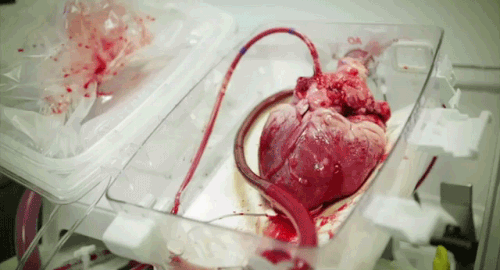Artificial Organs -Solving the Organ Transplant Crises
-
119,926 people need an organ transplant but only 77,233 are active on the organ transplant list.
-
24,892 transplant surgeries were performed in January to September 2016.
-
Only 11,776 people donated organs this year.
-
22 patients die everyday, waiting for a transplant.
-
Every 10 minutes, another person is added to the transplant list.
-
Even though over 95% of U.S. adults support organ transplantation, only about 48% of people actually donate their organs.
-
Only 30,970 people were able to receive organ transplant surgery in 2015.
-
1 person can donate up to 8 organs.
-
Heart, 2 lungs, liver, pancreas, 2 kidneys and intestine.
-
Japanese Researchers Repair Monkey Hearts with Artificial Stem Cells
October 11, 2016
A team from Japan has succeeded in restoring some cardiac functioning in monkeys that have suffered heart attacks with artificial stem cells. It helped the monkeys to improve the functioning of the hearts by about 10 percents.
Quick Links on Artificial Organs
Articles About Artificial Organs
Life Saving Discoveries on Artificial Organs
News about Artificial Organs
Did You Know? (In U.S.A)
How Artificial Organs are Made
 |  |  |
|---|---|---|
 |  |
Bio-artificial organs are created with the recipient's stem cells wrapped around in a plastic object. Since the stem cells are from the patient's own body, his or her immune system will not reject and cause any problems. Doctors surgically reroute blood for the body to treat the organ like its regular tissues(H6). The very first successful bio-artificial organ that was grown in a lab was a bladder in 2006 (H7).
Learn About How Different Types of Artificial Organs Work

-
Donors are starting to decrease as the years go by from 2009 to 2013
-
From 1991 to 2013, the waiting list increased by 98,074 people over the course of 22 years
-
Only about 29,000 out of 121,000 people actually get transplants
-
Waiting list will continue to decrease if artificial organs are not allowed
Let's Look at The Expansion of Organ Transplant List Data
Did You Know? (Worldwide)
-
119,873 people donated their organs annually in 2014.
-
1.83% of donation increased over 2013.
-
The amount of donors decreased by 27,397 in 2014.
-
Average transplant hours worldwide is 13.6 hours.
-
Globally, at least 200,000 people are on waiting lists for kidneys.
-
About 10% of the 63,000 kidney transplantation carried out annually worldwide.
-
The top 5 countries that donated organs the most are Spain. Croatia, Malta, Belgium and Portugal.

LEARN ABOUT THE CREATION AND FOUNDERS OF ARTIFICIAL ORGANS
LEARN ABOUT THE COMPANIES THAT REVOLUTIONIZED ARTIFICIAL ORGANS
CHECK OUT THE SOURCES USED TO CREATE THIS WEBSITE
LEARN ABOUT THE ECONOMICAL, LEGAL, AND SOCIAL ISSUES REGARDING ARTIFICIAL ORGANS
LEARN MORE IN DETAILS ABOUT ARTIFICIAL ORGANS

LEARN ABOUT WHAT KIND OF ARTIFICIAL ORGANS EXIST

What are Artificial Organs?
Artificial organs are man-made devices that work like human organs to replace patients with non-working organs in order to function back to normal (H11). It is usually grown in a lab with stem cells. With this, thousands of people who suffers with organ failure will save them, their time and money.
Why are they Important?
Artificial organs benefit the society because it keeps people from serious organ failures. Also, patients do not have to wait for a donor and go through lab experiments to see if it is eligible to transplant an organ to the patient (H12). Since the number of people who are willing to donate their organs are decreasing significantly every year, artificial organs can save millions who are waiting for a donor.







